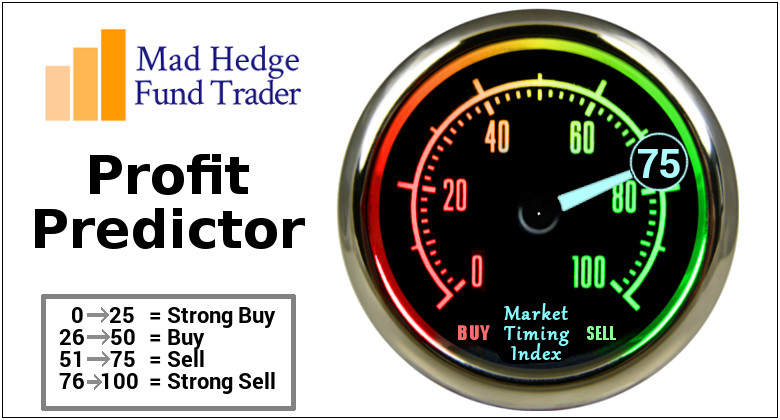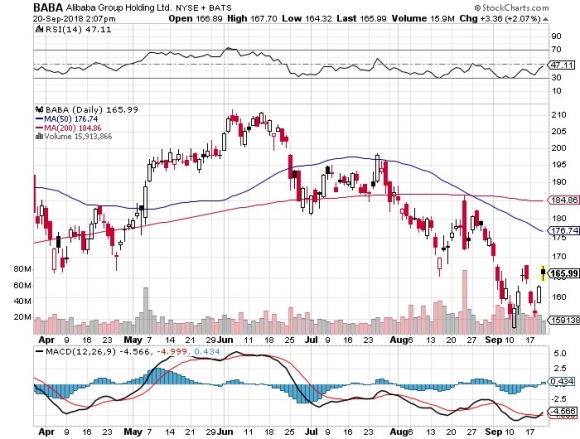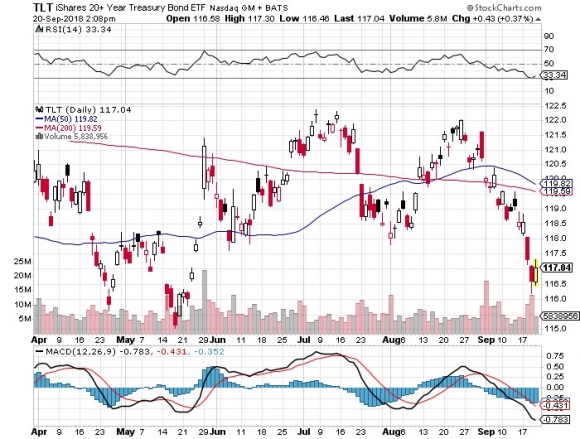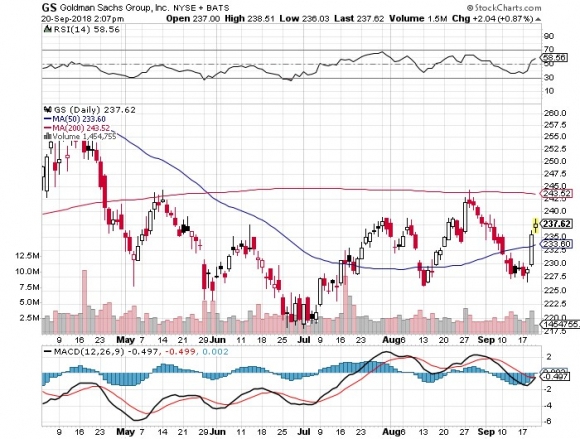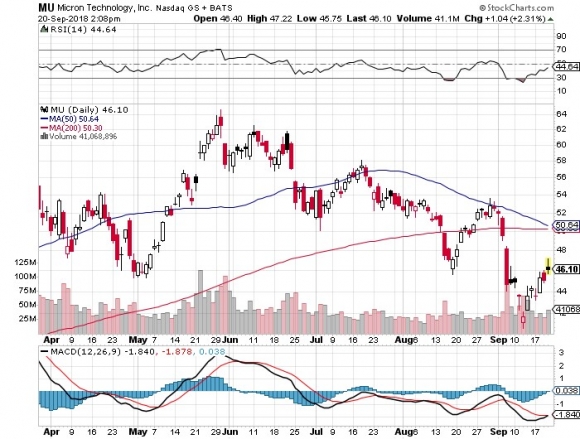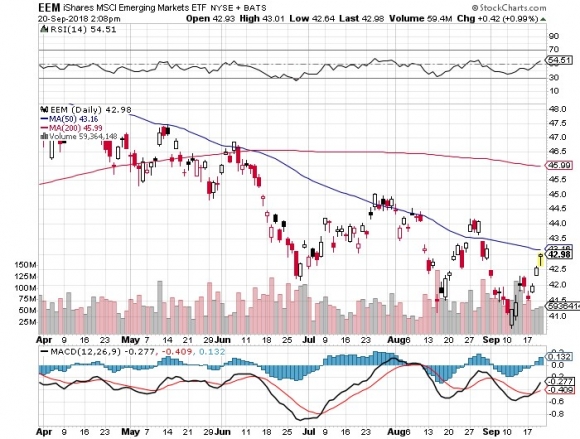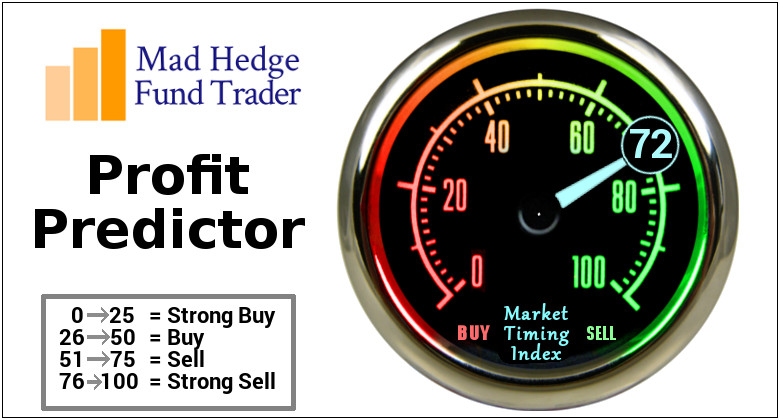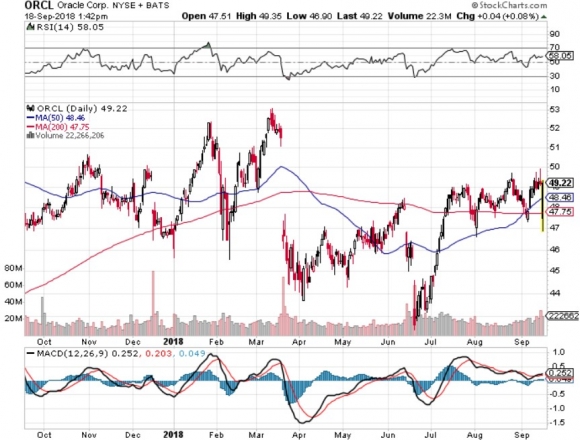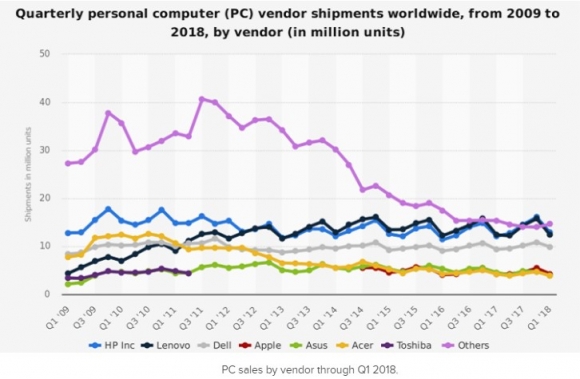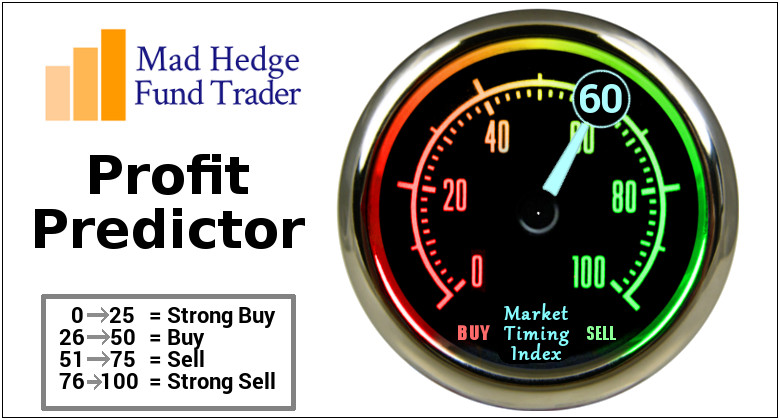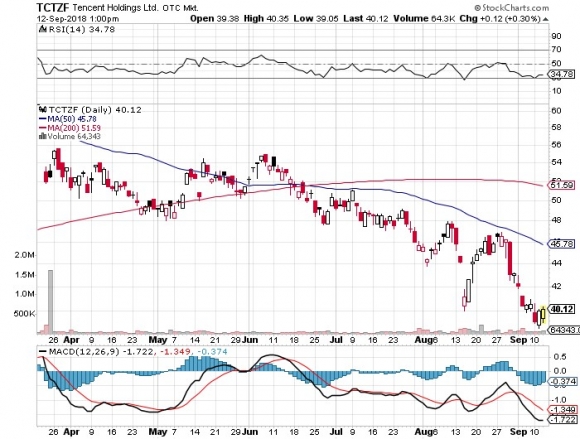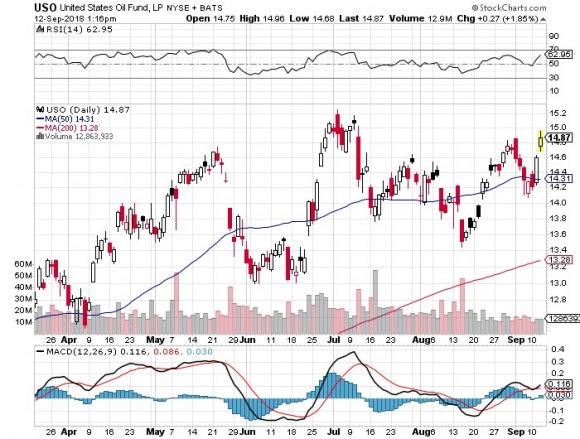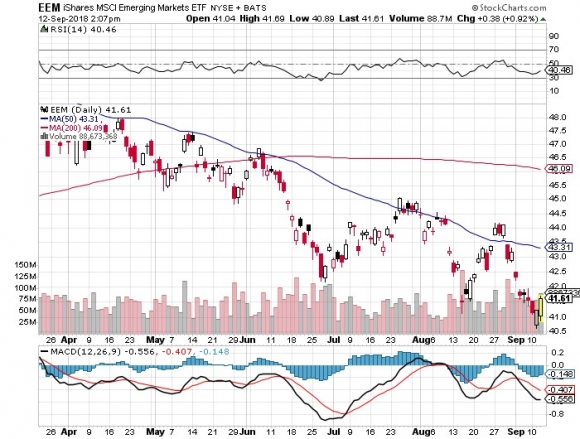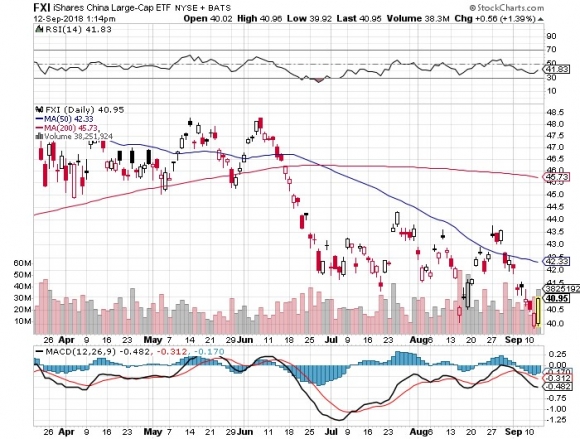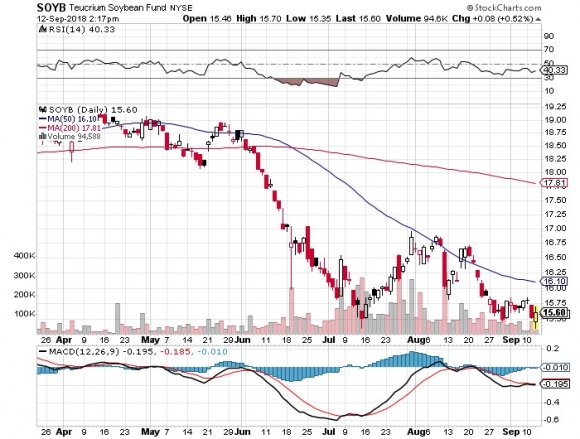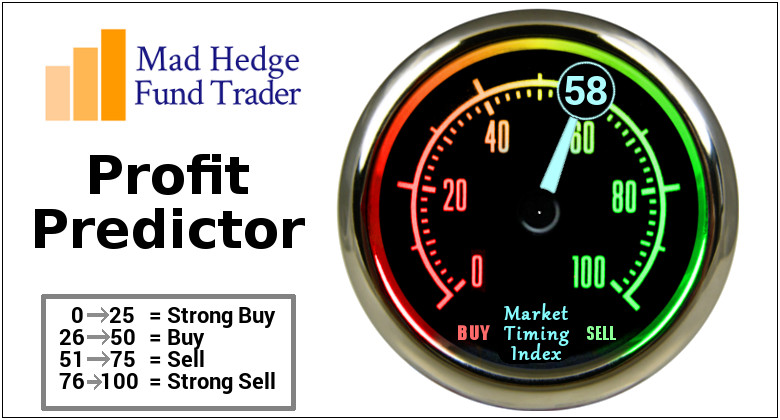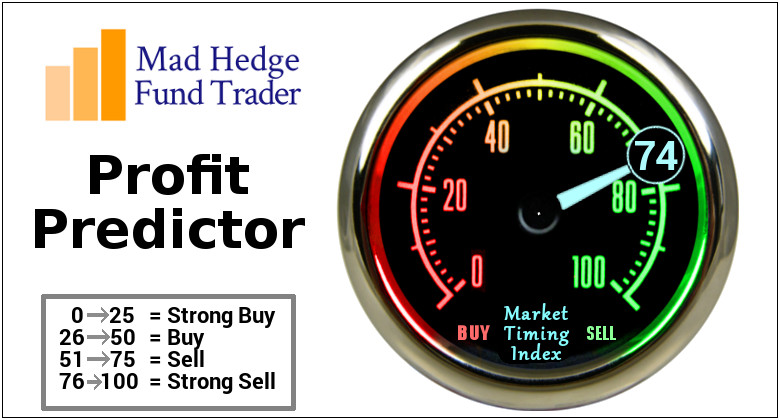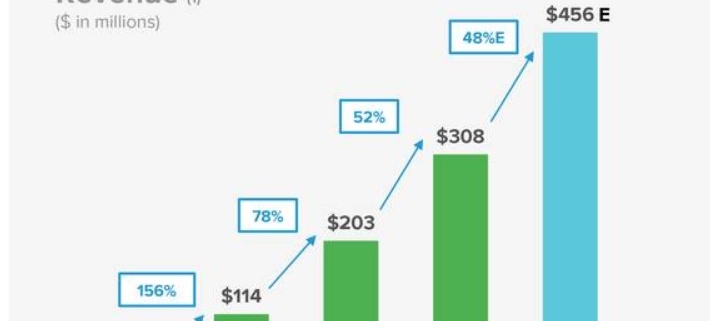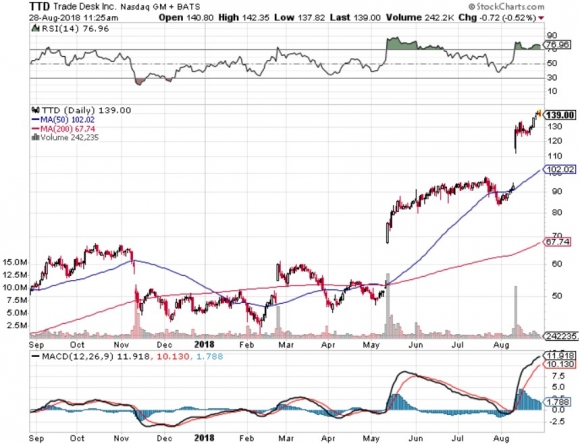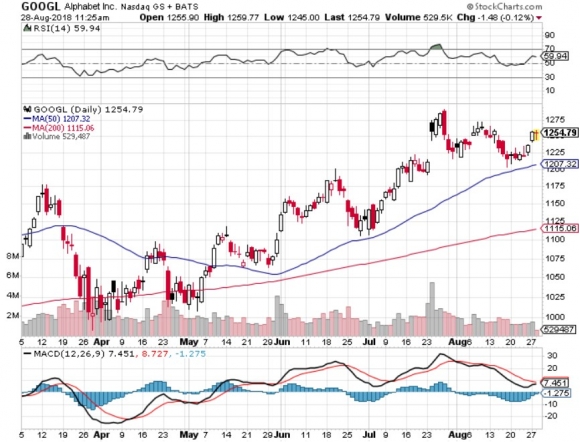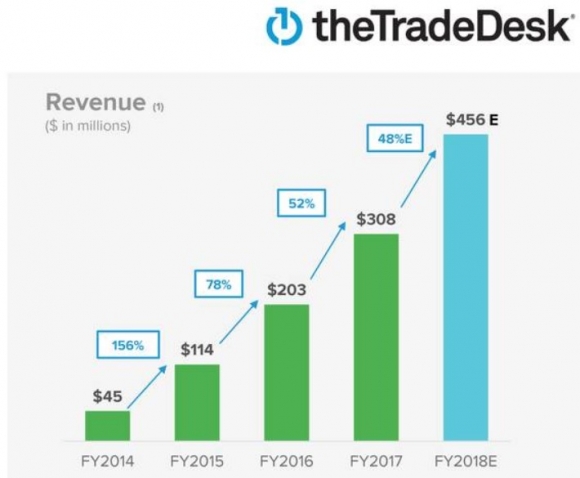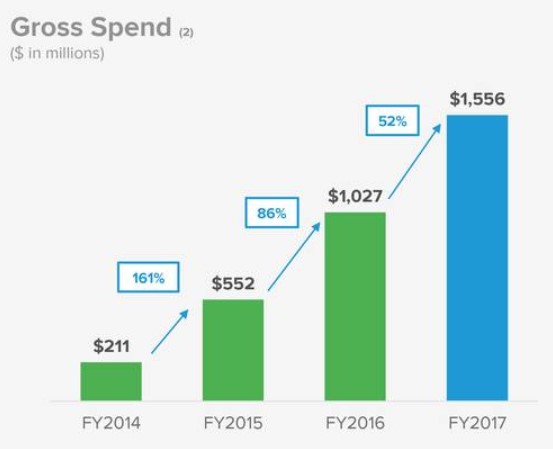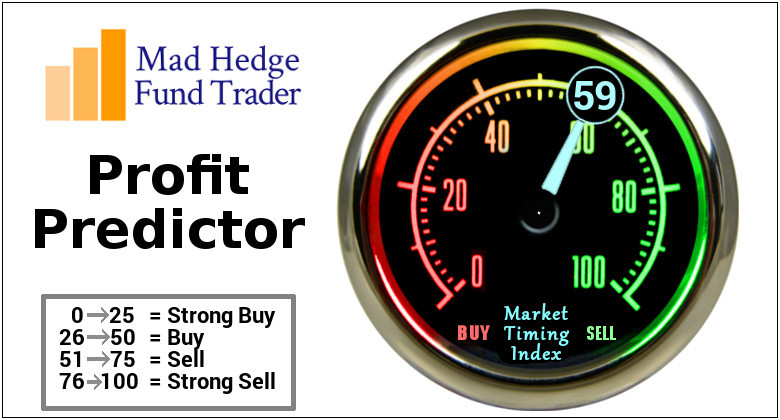Global Market Comments
September 21, 2018
Fiat Lux
Featured Trade:
(SEPTEMBER 19 BIWEEKLY STRATEGY WEBINAR Q&A),
(SPY), (VIX), (VXX), (GS), (BABA), (BIDU), (TLT), (TBT),
(TSLA), (NVDA), (MU), (XLP), (AAPL), (EEM),
(MONDAY, OCTOBER 15, 2018, ATLANTA, GA,
GLOBAL STRATEGY LUNCHEON)
Posts
Below please find subscribers’ Q&A for the Mad Hedge Fund Trader September 19 Global Strategy Webinar with my guest and co-host Bill Davis of the Mad Day Trader.
As usual, every asset class long and short was covered. You are certainly an inquisitive lot, and keep those questions coming!
Q: Do you expect a correction in the near term?
A: Yes. In fact, we may even see it in October. Markets (SPY) have been in extreme, overbought territory for a month now, the macro background is terrible, trade wars are accelerating, and interest rates are rising sharply. The only thing holding the market up is the prospect of one more quarter of good earnings, which companies start reporting next month. So once that’s out of the way, be careful, because people are just hanging on to the last final quarter before they sell.
Q: I just got out of my cannabis stock, what should I do now?
A: Thank your lucky stars you got away with that—it was an awful trade and you made money on it anyway. Stay away in droves. After all, the cannabis industry is all about growing a weed and how hard is that? This means the barriers to entry are zero. In fact, I’m thinking of growing some in my own backyard. My tomatoes do well, so why not Mary Jane?
Q: The Volatility Index (VIX) is now at $11.79—should I buy?
A: No, the rule of thumb for the (VIX) is to wait for it to sit on a bottom for one to two weeks and let some time decay work itself out. You’ll see that in the ETF, the iPath S&P 500 VIX Short-Term Futures ETN (VXX). When it stops breaking to new lows, that means it’s ready for another bounce. I would wait.
Q: What do you think about banks here? Is it time to get in?
A: No, these are not promising charts. If anything, I’d say Goldman Sachs (GS) is getting ready to do a head and shoulders and go to new lows. I would stay away from financials unless I see more positive evidence. The industry is ripe for disruption from fintech, which has already started. That’s said, they are way overdue for a dead cat bounce. That’s a trade, not an investment.
Q: Would you short Alibaba (BABA) and Baidu (BIDU) here?
A: No. Shorting is what I would have done six months ago; now it’s far too late. If anything, I would be a buyer of those stocks here, based on the possibility that we will see progress or an end to the trade war in the next couple of months. If the trade wars continue, they will put the U.S. in recession next year, and then you don’t want to own stocks anywhere.
Q: Is Apple (AAPL) going to get hit by the trade wars?
A: So far, this has not been the case, but they are whistling past the graveyard right now—an obvious target in the trade wars from both sides. For instance, the U.S. could suddenly start applying a 25% import duty to iPhones from China, which would make your $1,000 phone a $1,250 phone. Similarly, the Chinese could hit it in China, restricting their manufacturing in one way or another. I’m being very cautious of Apple for this reason. The stock already has one $10 drop just because of this worry.
Q: Can the U.S. ban China from selling bonds?
A: No, they can’t. The global U.S. Treasury bond market (TLT) is international by nature—there is no way to stop the selling. It would take a state of war to reach the point where the Fed actually seizes China’s U.S. Treasury bond holdings. The last time that happened was when Iran seized the U.S. embassy in Tehran in 1979. Iran didn’t get its money back until the Iran Nuclear Deal in 2015. Before that you have to go back to WWII, when the U.S. seized all German and Japanese assets. They never got those back.
Q: What are your thoughts on the chip sector?
A: Stay away short-term because of the China trade war, but it’s a great buy on the long term. These stocks, like NVIDIA (NVDA) and Micron Technology (MU) have another double in them. The fundamentals are outrageously good.
Q: Is the market crazy, or what?
A: Yes, it is crazy, which is why I’m keeping 90% cash and 10% on the short side. But “Markets can remain irrational longer than you can stay liquid,” as my friend John Maynard Keynes used to say.
Q: What’s your take on the Consumer Staples sector (XLP)?
A: It will likely go up for the rest of the year, into the Christmas period; it’s a fairly safe sector. The uptrend will remain until it doesn’t.
Q: Should we buy TBT now?
A: No, the time to buy the ProShares Ultra Short 20+ Year Treasury ETF (TBT) was two months ago. Now is the time to sell and take profits. I don’t think 10-year U.S. Treasury yields (TLT) are going above 3.11% in this cycle, and we are now at 3.07%. Buy low and sell high, that’s how you make the money, not the opposite.
Q: Does this webinar get posted on the website?
A: Yes, but you have to log in to access it. Then hover your cursor over My Account and a drop-down menu magically appears. Click on Global Trading Dispatch, then the Webinars button, and the last nine years of webinars appear. Pick the webinar you want and click on the “PLAY” arrow. Just give us a couple of hours to get it up.
Q: Can Chinese companies use Southeast Asia as a conduit to export to the U.S.?
A: Yes. This is an old trick to bypass trade restrictions. For example, most of the Chinese steel coming into the U.S. is through third countries, like Singapore. Eventually they do get found out, at which point companies or imports from Vietnam will be identified as Chinese origin and get hit with the import duties anyway, but it could take a year or two for those illegal imports to get discovered. This has been going on ever since trade started.
Q: Will the currency crisis in Argentina and Turkey spread to a global contagion?
A: Yes, and this could be another cause of a global recession late next year. The canaries in the coal live there (EEM).
Q: Would you use the DOJ probe to buy into Tesla (TSLA)?
A: No, buy the car, not the stock as it is untradeable. This is in fact the third DOJ investigation Tesla has undergone since Trump came into office. The last one was over how they handled the $400 million they have in deposits for their 400,000 orders. It turns out it was all held in an escrow account. There are easier ways to make money. It’s a black swan a day with Tesla. This is what happens when you disrupt about half of the U.S. GDP all at once, including autos, the national dealer network, big oil, and advertising. All of these are among the largest campaign donors in the U.S.
Time to Bring Out the Big Guns
Mad Hedge Technology Letter
September 19, 2018
Fiat Lux
Featured Trade:
(IBM’S SELF DESTRUCT),
(IBM), (BIDU), (BABA), (AAPL), (INTC), (AMD), (AMZN), (MSFT), (ORCL)
International Business Machines Corporation (IBM) shares do not need the squeeze of a contentious trade war to dent its share price.
It is doing it all by itself.
Stories have been rife over the past few years of shrinking revenue in China.
And that was during the golden years of China when American tech ran riot on the mainland before the dynamic rise of Baidu (BIDU), Alibaba (BABA), and Tencent, otherwise known as the BATs.
Then the Oracle of Omaha Warren Buffett drove a stake through the heart of IBM shares earlier this year by announcing he was fed up with the company’s direction and dumped a 35-year position.
Buffett unloaded all of his shares in favor of putting down an additional 75 million shares in Apple (AAPL) in the first quarter of 2018.
Topping off his Apple position now sees Buffett owning a mammoth 165.3 million total shares in the resurgent tech company.
Buffett’s shrewd decision has been rewarded, and Apple’s stock has rocketed more than 20% since he jovially declared his purchase in May.
IBM has been a rare misstep for Buffett, who took a moderate loss on his IBM position disclosing an average cost basis of $170 on 64 million shares that Berkshire bought in 2011.
IBM has flatlined since that Buffett interview, and slid around 25% since its peak in mid-2014.
IBM is grappling with the same conundrum most legacy companies deal with – top line contraction.
In 2014, IBM registered a tad under $93 billion in annual revenue, and followed up the next three years with even lower revenue.
A horrible recipe for success to say the least.
In an era of turbo-charged tech companies whose value now comprise over a quarter of the S&P, IBM has really fluffed its lines.
IBM’s prospects have been stapled to the PC market for years.
A recent JP Morgan note revealed the PC market could contract by 5% to 7% in the fourth quarter because of CPU shortages from Intel (INTC).
The report’s timing couldn’t have been worse for IBM.
The PC industry has been tanking for the past six consecutive years unable to shirk shrinking volume.
Intel is another company I have been lukewarm on lately because it is being outmaneuvered by chip competitor Advanced Micro Devices (AMD).
Even worse, this year has been a bad one for Intel’s management, which saw former CEO Brian Krzanich resign for sleeping with a coworker.
The poor management has had a spillover effect with Intel needing to delay new product launches as well.
To read more about my timely recommendation to pile into AMD in mid-August at $19, please click here.
Meanwhile, AMD shares have gone parabolic and surpassed an intraday price of $34 recently.
Investors should ask themselves, why invest in IBM when there are so many other tech companies that are growing, and growing revenue by 20% or more per year?
If IBM does manage to eke out top line growth in 2018, it will be by 1% to 2%, similar to Oracle’s recent performance.
Unsurprisingly, the price action of Oracle (ORCL) for the past year has been flatter than a bicycle ride around Beijing.
Live by the sword and die by the sword.
Thus, the Mad Hedge Technology Letter has been ushering readers into high-performance stocks that will bring technological and societal changes.
If you put a gun to my head and forced me to give sage investment advice, then the answer would be straightforward.
Buy Amazon (AMZN) and Microsoft (MSFT) on the dip and every dip.
This is a way to print money as if you had a rich uncle writing you checks every month.
Legacy tech is another story.
The IBMs and the Oracles of the world are bringing up the tech sector’s rear.
To add insult to injury, the lion’s share of IBM’s revenue is carved out from abroad, and the recent surge in the dollar is not doing IBM any favors.
IBM’s Watson initiative was billed as the savior for Big Blue.
The artificial intelligence initiative would integrate health care data into an actionable app.
The expectations were high hoping this division would drag up IBM from its long period of malaise.
IBM bet big on this division ploughing more than $15 billion into it from 2010-2015, predicting this would be the beginning of a new renaissance for the historic American company.
This game changing move fell on deaf ears and has been a massive bust.
IBM swallowed up three companies to ramp up this shift into the AI world - Phytel, Explorys, and Truven.
The treasure trove of health care data and proprietary analytics systems these companies came with were what this division needed to turn the corner.
These three companies were strong before the buy out and engineers were upbeat hoping Watson would elevate these companies to another level.
Wistfully, IBM Management led by CEO Ginni Rometty grossly mishandled Watson’s execution.
Phytel boasted 160 engineers at the time of IBM’s purchase and confusingly slashed half the workforce earlier this year.
Engineers at the firm even lamented that now, even smaller firms were “eating them alive.”
Unimpressed with the direction of the artificial intelligence division at IBM, many of these three companies’ best and brightest engineers jumped ship.
The inability for IBM to integrate Watson reared its ugly head in plain daylight when MD Anderson Cancer Center in Texas halted its Watson project after draining $62 million.
This was one of many errors that Watson AI accrued.
The failure to quicken clinical decision-making to match patients to clinical trials was an example of how futile IBM had become.
In short, a spectacular breakdown in execution mixed with an abrupt brain drain of AI engineers quickly imploded the prospect of Watson ever succeeding.
In 2013, IBM confidently boasted that Watson would be its “first killer app” in health care.
Internal leaks shined a brighter light on IBM’s subpar management skills.
One engineer described IBM’s management as having “no idea” what they were doing.
Another engineer said they were uncertain of a “road map” and “pivoted many times.”
Phytel, an industry leader at the time focusing on population health management, was bleeding money.
The engineers explained further, chiming in that IBM’s management had zero technical experience that led management wanting to create products that were “simply impossible.”
Not only were these products impossible, but they in no way took advantage of the resources these three companies had at their disposal.
Do you still want to invest in IBM?
Fast forward to today.
IBM is being sued in federal court with the plaintiff’s, former employees at the firm, claiming the company unfairly discriminated against elderly employees, firing them because of their age.
The documents submitted by the plaintiff’s state that “IBM has laid off 20,000 employees who were over the age of 40” since 2012.
This prototypical legacy company has more problems than the eye can see in every nook and cranny of the company.
If you have IBM shares now, dump them as soon as you can and run for cover.
It’s a miracle that IBM shares have eked out a paltry gain this year. And this thesis is constant with one of my overarching themes – stay away from all legacy tech firms with no cutting-edge proprietary technologies and stagnating growth.
A Sad Story of Mismanagement
________________________________________________________________________________________________
Quote of the Day
“Some say Google is God. Others say Google is Satan. But if they think Google is too powerful, remember that with search engines unlike other companies, all it takes is a single click to go to another search engine,” said Alphabet cofounder Sergey Brin.
Global Market Comments
September 13, 2018
Fiat Lux
Featured Trade:
(EXPANDING MY “TRADE PEACE” PORTFOLIO),
(BABA), (BIDU), (TCTZF) (MU), (LRCX), (KLAC), (EEM),
(FXI), (EWZ), (SOYB), (CORN), (WEAT), (CAT), (DE),
(THE LEAGUE OF EXTRAORDINARY TRADERS)
This morning, U.S. Treasury Secretary Steven Mnuchin mentioned that an effort was being made to get trade talks with China back on track. The Dow soared 160 points in a heartbeat.
Past murmurings by the Treasury Secretary demonstrate that his musings have zero credibility in the marketplace and the move vaporized in minutes. However, given the extreme moves made by the shares of trade war victims, I think it is time to review my “Trade Peace” portfolio and make some additions.
The shares have been so beaten up that I think you can start scaling in now with limited downside and a ton of potential upside.
It’s not a matter of if, but when Trump has to run up the white flag with his wildly unpopular trade wars. As they now stand the new tariffs are threatening to chop $10 off of S&P 500 earnings in 2018, from $168 down to $158, according to J.P. Morgan. Some two-thirds of all U.S. companies have been negatively impacted.
Tariffs have effectively wiped out the benefits of the corporate tax cuts for most companies enacted last December. Who has been the worst hit? Thousands of small manufacturers in Midwest red states that can’t function because they are missing crucial cheap parts they can only obtain from the Middle Kingdom.
At last count there are a staggering 37,000 applications for exemptions from tariffs filed with the U.S. Treasury and only a dozen people to process them. A mere 10% have been granted. It is a giant bureaucratic nightmare.
With the midterm elections now only 37 trading days away, the clock is ticking. If Trump doesn’t cut trade deals with all of our major counterparties around the world before then, the Republican Party stands to lose both the House of Representatives and the Senate on November 6. That will make Trump a “lame duck” president for two more years.
China Technology Stocks – Includes Alibaba (BABA), Baidu (BIDU), and Tencent (TCTZF). It’s not often that you get to buy a company with 61% sales growth, which has seen its shares plunge by 27% in three months, as is the case with (BABA). Just to get (BABA) back up to its June level it has to rise by 37%. This is a stock that will easily double or triple over the long term.
U.S. Semiconductor Stocks – With China buying 80% of its chips from the U.S., stocks such as Micron Technology (MU), Lam Research (LRCX), and KLA-Tencor (KLAC) have been taken out to the woodshed and beaten senseless. Micron is off a withering 41% since the trade war began in earnest in May.
Emerging Markets – China is the largest trading partner for most of the world, and a recession there sparks a global contagion effect. Reverse that, and you stimulate not only emerging markets, but the U.S. economy, too. Look at the charts for the iShares MSCI Emerging Markets ETF (EEM), the iShares China Large-Cap ETF (FXI), and the iShares MSCI Brazil ETF (EWZ) and you will salivate.
Oil – Boost the global economy and oil demand (USO) also. China is the world’s largest incremental buyer of new oil, and it will absorb all of the Iranian crude freed up by the U.S. abrogation of the treaty there.
Agricultural – No sector has been punished more than agriculture, where profit margins are small, lead times stretch into years, and mother nature plays her heavy hand. In this area you can include soybeans (SOYB), corn (CORN), and wheat (WEAT), as well as equipment makers Caterpillar (CAT) and Deere (DE).
Some 20 years of development efforts in China by American farmers have gone down the toilet, and much of this business is never coming back. Trust and reliability are gone for good. Storage silos across the country are full. Did I mention that red states are taking far and away the biggest hit? There are not a lot of soybeans grown in California, New York, or New Jersey.
Even if Trump digs in and refuses to admit defeat, as is his way, there is still a light at the end of the tunnel. Sometime in 2019, the World Trade Organization will declare virtually all of the new American tariffs illegal and hit the U.S. with its own countervailing duties. This is the Chinese strategy. Waiting for them to fold could be a long wait, a very long wait.
Time to Look at the “Trade Peace” Portfolio?
Global Market Comments
September 12, 2018
Fiat Lux
THE FUTURE OF AI ISSUE
Featured Trade:
(THE NEW AI BOOK THAT INVESTORS ARE SCRAMBLING FOR),
(GOOG), (FB), (AMZN), MSFT), (BABA), (BIDU),
(TENCENT), (TSLA), (NVDA), (AMD), (MU), (LRCX)
Mad Hedge Technology Letter
August 29, 2018
Fiat Lux
Featured Trade:
(THE BEST TECH STOCK YOU’VE NEVER HEARD OF),
(TTD), (AMZN), (GOOGL), (NFLX), (BIDU), (BABA), (SPOT), (P), (FB)
If you asked me which is the best company that most people do not know about then there is one clear answer.
The Trade Desk (TTD).
This company was founded by one of the pioneers of the ad tech industry Jeff Green, and he has spent the past 20 years improving data-based digital advertising.
Green established AdECN in 2004 and its claim to fame was the world’s first online ad exchange.
After three years, Microsoft gobbled up this firm and Green stayed on until 2009 when he launched The Trade Desk. This is where he planned to infuse everything he learned about the digital ad agency into his own brainchild.
Green concluded that creating a self-service platform, avoiding privacy issues, and harnessing big data for digital ad campaigns was the best route at the time.
Green hoped to avoid the pitfalls that damaged the digital ad industry mainly bundling random ads together that diluted the quality and potency of the ad campaigns.
It did not make sense that a digital ad for baby diapers could be commingled with an ad for retirement homes.
Green created real-time bidding (RTB), which is a process in which an ad buyer bids on a digital ad and, if won, the buyer’s ad is instantly displayed on the selected site.
This revolutionary method allowed ad buyers to optimize ad inventory, prioritize ad channels, and boost the effectiveness of campaigns.
(RTB) is a far better way to optimize digital ad campaigns than static auctions, which group ads by the thousand.
In real time, advertisers are able to determine a bespoke ad for the user to display on a website. Green used this model to develop his company by building a platform tailor-made to execute (RTB).
Naturally, he won over many naysayers and his company took off like a rocket.
Results, in a results-based business, were seen right away by ad buyers.
A poignant example was aiding a performance-based ad agency in trimming ad waste by more than 50% for a national fast food chain with thousands of locations across America.
It took just one year for The Trade Desk to carve out a profitable business as ad agencies flocked to its platform desiring to take advantage of (RTB) or also commonly known as programmatic advertising.
Customer satisfaction is evident in its client retention rate of 95% for the past few years highlighting the dominating position The Trade Desk possesses in the digital ad industry.
The Trade Desk has not raised fees for ad buyers lately, but the value added from The Trade Desk to customers is accelerating at a brisk pace.
A great value proposition for potential clients.
The vigor of the business was highlighted when Green cited that each second his company is “considering over 9 million ad opportunities” for their ad inventory shows how The Trade Desk is up to date on almost every single ad permutation out there.
This speaks volume of the ad tech, which is the main engine powering the bottom lines at Google search and rogue ad seller Facebook (FB).
Google only gets 63,000 searches per second and shows that The Trade Desk has pushed the envelope in providing the best platform for ad buyers to seek its perfect audience.
Green’s mission of supporting big ad buyers optimize their ad budget has really caught fire and in a way that is completely transparent and objective.
The foundations that Green has assembled became even more valuable when Alphabet (GOOGL) chose to remove DoubleClick IDs, which would now prevent ad buyers from cross-platform reporting and measurement.
Previously, DoubleClick ID could cull data from assorted ads and online products based on a unique user ID named DoubleClick ID.
Ad purchasers then would data transfer to pull DoubleClick log files and measure them against impressions served from other ad servers across the web.
Effectively, ad buyers could track the user through the whole ad process and determine how useful an ad would be to that specific user.
In an utter conservative move to satisfy Europe’s General Data Protection Regulation (GDPR), DoubleClick IDs are no longer available for use, and tracking the ad inventory performance from start to finish became much harder.
Cutting off the visibility of the DoubleClick ID in the DoubleClick ecosystem was a huge victory for The Trade Desk because DoubleClick ID measured 75% of the global ad inventory.
Ad buyers would be forced to find other measurement systems to help calculate ad performance.
Branding and executing as the transparent and fair ad platform helping ad agencies was a great idea in hindsight with the world becoming a great deal more sensitive to data privacy.
The Trade Desk is perfectly placed to reap all the benefits and boast excellent technology to capitalize on this changing big data landscape. It is already seeing this happen with new business wins including large global brands such as a major food company, a global airline, and another large beverage company.
The global digital ad market is a $700 billion market today and trending toward $1 trillion in the next five to seven years
The generational shift to mobile and online platforms will invigorate The Trade Desk’s bottom line as more big ad buyers will make use of its proprietary platform to place programmatic ads.
Content distribution systems are fragmenting into skinny bundles hyper-targeting niche content users such as Sling TV, FuboTV, and Hulu.
There are probably 30 different ways to watch ESPN now, and these 30 platforms all require ad placement and optimization.
Some of the names The Trade Desk is working with are the who’s who of digital content ownership or distribution including Baidu (BIDU), Google, Alibaba (BABA), Pandora (P), and Spotify (SPOT) -- and the names are almost endless.
It’s the Wild West of ads and content these days because TV distribution has never been more fragmented.
Content creation avenues are desperate to boost ad income and are increasingly attempting to go direct to consumers.
Ad-funded Internet TV barely existed a few years ago. And ad inventory is all up for grabs benefitting The Trade Desk.
All of this explains why the stock is up more than 180% in 2018, and this is just the beginning.
The growth numbers put Amazon (AMZN) and Netflix (NFLX) to shame.
The Trade Desk scale on inventory has spiked by more than 700% YOY.
The option to hyper-target increases as more ad inventory is stocked.
Management mentioned in its second-quarter performance that “nearly everything went right. We executed well and one of the most dynamic environments we've seen.”
It is one of the most bullish statements I have heard from a public company.
Quarterly revenue ballooned 54% YOY to a record $112 million, and the 54% YOY growth equaled the 54% YOY growth in Q2 2017.
Ad Age's top 50 worldwide advertisers doubled ad spend in the past year positioning The Trade Desk for continued hyper-growth, not only for 2018 but in 2019 and beyond.
Mobile spend jumped nearly 100% YOY, accounting for 45% of ad spend on the platform, which is 400% higher than the industry average for mobile ad spend according to eMarketer.
Data spend was also a huge winner rising by nearly 100% smashing another record.
In the meantime, the overseas business continued its robust growth in Europe and Asia, up 85% YOY.
The Trade Desk confidence in its performance chose to increase guidance to $456 million for the year, a 48% YOY improvement.
When upper management says “when we see surprises, they typically are to the upside” you take notice, because this tech company is perfectly placed in a growth sweet spot.
Massive developing markets are just starting to dabble with programmatic advertising. Markets such as China will see it become the new normal soon, opening up even more business for The Trade Desk.
The Trade Desk is also rolling out new products that will automate more of the process and reduce the number of clicks.
Wait for the pullback to get into this ad tech stock because even though it is up big this year, we are still in the early innings, and shares will march even higher.
________________________________________________________________________________________________
Quote of the Day
“I have a deep respect for the fundamentals of television, the traditions of it, even, but I don't have any reverence for it,” – said Netflix chief content officer Ted Sarandos.
Global Market Comments
August 24, 2018
Fiat Lux
Featured Trade:
(AUGUST 22 BIWEEKLY STRATEGY WEBINAR Q&A),
(BIDU), (BABA), (VIX), (EEM), (SPY), (GLD), (GDX), (BITCOIN),
(SQM), (HD), (TBT), (JWN), (AMZN), (USO), (NFLX), (PIN),
(TAKING A BITE OUT OF STEALTH INFLATION)
Legal Disclaimer
There is a very high degree of risk involved in trading. Past results are not indicative of future returns. MadHedgeFundTrader.com and all individuals affiliated with this site assume no responsibilities for your trading and investment results. The indicators, strategies, columns, articles and all other features are for educational purposes only and should not be construed as investment advice. Information for futures trading observations are obtained from sources believed to be reliable, but we do not warrant its completeness or accuracy, or warrant any results from the use of the information. Your use of the trading observations is entirely at your own risk and it is your sole responsibility to evaluate the accuracy, completeness and usefulness of the information. You must assess the risk of any trade with your broker and make your own independent decisions regarding any securities mentioned herein. Affiliates of MadHedgeFundTrader.com may have a position or effect transactions in the securities described herein (or options thereon) and/or otherwise employ trading strategies that may be consistent or inconsistent with the provided strategies.

